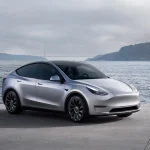
Optimizing For Electric Miles: One Reader Does The MathOptimizing For Electric Miles: One Reader Does The Math
It’s one of the main points of dispute among electric-car buyers and advocates: What is the “right” number of all-electric miles?
Some say maximal range is needed, e.g. the EPA-rated 73 miles of the Nissan Leaf or the promised 320 miles of the highest-spec 2012 Tesla Model S (that’s not an EPA rating, by the way).
Others say the Chevy Volt, with a 35-mile rating, covers the vast majority of situations, since two-thirds of U.S. vehicles cover less than that every day.
Then there’s the 2012 Toyota Prius Plug-In, which gives 6 to 15 miles of electric range–and they may not be continuous, since it will switch on its engine under hard acceleration.
Our reader John C. Briggs decided to look at data from the Fuel.ly website to shed some light on the real-world impact of the two approaches in the Volt and the plug-in Prius.
The website lists 12 plug-in Priuses tracked for 23,086 miles, which collectively produced an average 68 mpg. By comparison, the regular 2012 Priuses on the same site got 48.4 mpg. This means 29 percent of the miles traveled by the Prius Plug-Ins are electric miles–better than he would have expected.
In the case of the Volt, the site shows four 2012 Volts traveling 20,188 miles and getting 86.8 mpg, plus two 2011 Volts traveling 13,405 miles and getting 123.3 mpg.
If we assume the Volt gets the EPA-rated 37 mpg when running on gasoline, that translates into 57 and 70 percent of the miles run on electricity respectively. That’s a good number, but as good as Briggs had expected.
We would also note that the data doesn’t appear to show average trip length or how often each model is recharged . If one car travels longer average distances without plugging in, that will skew the results.
If, for example, plug-in Prius drivers take many shorter trips and plug in for a couple of hours often, their electric percentage may be higher than Volt drivers who do long-distance highway runs. And the reverse is true as well.
2012 Chevrolet Volt
(Of course, purists will point out that the Nissan LEAF runs all its miles made on electricity, and rightly so.)
Granted the number of vehicles on fuel.ly are small, and the cars belong to the earliest of early adopters. However, if the numbers hold up over time, it could show that the while the plug-in Prius is only half as good at racking up electric miles as the Volt, it does so with a battery that is one-quarter the size and (presumably) one quarter the price.
That would be impressive if there were a cost advantage to the consumer, but a 2012 Volt starts at $39,995 and a 2012 Prius Plug-In at $32,760.
“The more I think about it,” Briggs says, “the less I care about the technology–whether it’s extended-range electric in the Volt versus blended-mode hybrid technology in the plug-in Prius.”
The Volt “seems” better and the car has better driving dynamics, but Briggs cares most about percentage of miles traveled on electricity. “If I can get to 75 percent of my miles traveled on electric, I don’t care so much how that’s achieved.”
We agree with Briggs that this seems like a great optimization problem weighing battery cost-per-kilowatt-hour, your local electricity rate, the length(s) of your daily drive(s), and how often you’re willing to plug in (and whether you can).
And then, what’s the metric you are most comfortable using? Car cost? Overall energy cost (gasoline plus electricity)? Minimizing wells-to-wheels carbon emissions? Or simply the satisfaction of knowing you’ve used as little gasoline as possible?
Those answers will vary for each individual buyer. Different carmakers (Toyota vs. Chevrolet vs. Nissan) have staked their bets on different answers.
Briggs notes he expected the Prius Plug-Ins to log lower electric mileage than they did, and the Volts to travel more on electricity than they did. Clearly more information about buyers and their travel habits is needed to let shoppers work out which is best for them.
But we’re fond of data here, and we appreciate Briggs’ efforts at crunching the numbers to provide more discussion points.
+++++++++++
Follow GreenCarReports on Facebook and Twitter.
View original article at : “https://www.greencarreports.com//news/1075764_optimizing-for-electric-miles-one-reader-does-the-math”
Add a comment Cancel reply
Comments (0)
สมัคร LSM99 ระบบออโต้
… [Trackback]
[…] Find More Info here to that Topic: autoseu.com/optimizing-for-electric-miles-one-reader-does-the-mathoptimizing-for-electric-miles-one-reader-does-the-math/ […]
LSM99LIVE เว็บตรงของแท้ อันดับ 1
… [Trackback]
[…] Read More on that Topic: autoseu.com/optimizing-for-electric-miles-one-reader-does-the-mathoptimizing-for-electric-miles-one-reader-does-the-math/ […]
ดูบอลออนไลน์
… [Trackback]
[…] Read More here to that Topic: autoseu.com/optimizing-for-electric-miles-one-reader-does-the-mathoptimizing-for-electric-miles-one-reader-does-the-math/ […]
Categories
- Activism (1)
- Adventure (1)
- Advertising (2)
- Agriculture (1)
- Air pollution (4)
- Air transport (3)
- aluminium (2)
- Amazon (3)
- Animals (1)
- Apple (2)
- Architecture (1)
- Arctic (1)
- Artificial intelligence (1)
- Augmented Reality (1)
- Auto Detailing (1)
- autopilot (1)
- battery (31)
- Best summer holiday destinations 2022 (1)
- Bicycle (1)
- biodiversity (1)
- BMW (2)
- boat (1)
- Bus (1)
- Business (4)
- Buying Guides (1)
- car (7)
- Car industry (18)
- Car News (18)
- car rental (3)
- Car Reviews (4)
- Car sales (6)
- carbon emissions (15)
- carbon footprint (3)
- Carlos Ghosn (1)
- Cars (66)
- Central Europe (1)
- CES (2)
- charging station (11)
- Children (1)
- China (12)
- Citroën (1)
- city (1)
- City transport network (2)
- clean energy (2)
- Climate (1)
- climate change (9)
- Climate crisis (4)
- Climate emergency (2)
- climate protection (2)
- CO2 emissions (39)
- Company (3)
- Competition (1)
- Conscious travel (2)
- Contamination of water (1)
- Copper (2)
- cost of living (2)
- Cuba (1)
- Cuban politics (1)
- Cybertruck (1)
- Cycling (1)
- deforestation (1)
- delivery (3)
- Denmark (2)
- Detroit (1)
- Diesel (4)
- Diesel car (7)
- e-mobility (11)
- e-scooter (2)
- Eco travel (3)
- Eco-friendly (2)
- Ecology (1)
- Economy (1)
- El Niño (1)
- Electric (11,302)
- Electric boats (1)
- electric car (107)
- Electric Cars (499)
- Electricity (5)
- Electricity consumption (3)
- Electricity market (5)
- Elon Musk (21)
- emission (1)
- Emmanuel Macron (1)
- Energy (2)
- Energy low cost (1)
- energy transition (6)
- Entrepreneur (1)
- Environment (5)
- Environment pollution (1)
- Environmental protection (4)
- EU Policy (1)
- EU-China (2)
- Europe (7)
- Europe's energy crisis (1)
- European Commission (3)
- European economy (2)
- European Union (18)
- Euroviews (6)
- Eviction (1)
- EVs (37)
- F1 (1)
- factory (4)
- fake news (1)
- family (2)
- Ferrari (1)
- fertilizer (1)
- fine (penalty) (1)
- fire station service (1)
- flight (1)
- Flying car (4)
- Food security (1)
- Ford (1)
- Formula 1 (2)
- Fossil fuels (14)
- France (39)
- free trade (1)
- Fuel (3)
- Fuel cell electric vehicles FCEV (10)
- fuel crisis (2)
- Fuel Efficiency (3)
- fuel prices (1)
- Funeral (1)
- Gas (1)
- Gas Prices (1)
- gasoline price hike (1)
- German (1)
- Germany (8)
- Giorgia Meloni (1)
- Global warming and climate change (1)
- Good News (1)
- Greece (1)
- green energy (1)
- green new deal (1)
- Green transportation (17)
- Green Week (1)
- greenhouse gas emissions (6)
- Hanoi (19)
- Health (1)
- home (2)
- homelessness (1)
- Housing market (19)
- human rights abuse (1)
- Hybrid (2,283)
- Hybrids (116)
- Hydrogen (2)
- hydrogen vehicle (2)
- IAA Mobility (2)
- Iceland (3)
- incident (1)
- income (1)
- India (2)
- Indonesia (1)
- infrastructure (1)
- innovation (1)
- International relations (1)
- Investment (4)
- iPhone (1)
- Japan (1)
- Jobs (3)
- Joe Biden (4)
- Jubilee (1)
- Lampedusa (1)
- Las Vegas (1)
- lead petrol (2)
- Lithium (13)
- liveable cities (2)
- London (3)
- Luxembourg (1)
- Luxury (2)
- luxury goods (2)
- Luxury lifestyle (2)
- Manufacturing (5)
- Market (1)
- Markets (1)
- meat (1)
- Mercedes-Benz (39)
- Migrants (1)
- minerals (2)
- Mining (5)
- Mitsubishi Motors (1)
- Mobile World Congress (1)
- Mobility (10)
- Mobility Week (2)
- Mobility Week 2021 (1)
- Mobility Week 2023 (5)
- money (3)
- Motorcycling (2)
- Motorsport (1)
- Mountain (1)
- NASA (1)
- nature (2)
- net-zero (2)
- New technologies (6)
- Next Explainers (1)
- Next In data (2)
- Nigeria (1)
- Nissan (3)
- Norway (7)
- Nuclear Energy (1)
- nuclear fusion (1)
- Nuclear power plant (1)
- Odd (1)
- oil industry (1)
- Olaf Scholz (1)
- online shopping (1)
- Oslo (1)
- Paris (1)
- parody (1)
- Petroleum products (3)
- Peugeot (1)
- plastic (1)
- Poland (1)
- Politics (1)
- Pollution (44)
- Power Plant (1)
- prices (1)
- production (1)
- Profits (1)
- Prostitution (1)
- Public transport (4)
- Racing cars (1)
- Racism (1)
- Rail transport (2)
- rats (1)
- Raw material (1)
- Recycling (4)
- Renault (3)
- Renewable energies (6)
- renewable energy (6)
- Reykjavík (1)
- Rishi Sunak (1)
- road (36)
- Road infrastructures (1)
- Road safety (7)
- Road transport (20)
- road trip (1)
- Robot (1)
- Rolls Royce (1)
- Russia (1)
- Russia's invasion of Ukraine (2)
- Sadiq Khan (1)
- safari (1)
- Safety (1)
- Sale (1)
- sales (3)
- Scotland (1)
- self-driving (43)
- Semiconductor (1)
- Shares (1)
- Show (1)
- Silicone (1)
- Software (1)
- Solar energy (2)
- solar power (5)
- Space technology (1)
- Spain (1)
- start-up (3)
- Stock exchange transaction (1)
- Stock market activity (1)
- Stockholm (1)
- Strasbourg (1)
- Students (1)
- Summer Olympics (2)
- Sustainability (7)
- Sustainable city (3)
- Sustainable design (3)
- Sustainable development (1)
- Sustainable innovation (9)
- Sustainable technology (21)
- Sustainable tourism (4)
- Sweden (2)
- Tata Motors (2)
- Tax (37)
- Taxes (2)
- Taxi (1)
- Technology (55)
- Tesla (73)
- The Boring company (1)
- Tokyo Olympic Games 2020 (1)
- Toyota (4)
- trade (3)
- traffic (1)
- Trains (2)
- Transport (11)
- transportation (3)
- Travel destinations (1)
- Tunnel (1)
- Twitter (3)
- UBER (1)
- Ukraine war (1)
- Uncategorized (6)
- United Kingdom (5)
- United States (6)
- urban planning (2)
- Ursula von der Leyen (3)
- US politics (1)
- USA (1)
- vegan (1)
- vehicle (7)
- Video (4)
- Vietnam (19)
- Volkswagen (3)
- Volvo (2)
- waste (1)
- waste disposal (1)
- Water (1)
- Water resources (1)
- White House (1)
- wind energy (1)
- Wind turbine (1)
- Winter (2)
- work conditions (1)
- World Travel Market (1)
- Xiaomi (1)
Recent Posts
About us

Popular Tags
Related posts


Volvo EX30 in the test: Really a premium car at a volume price?

VW ID.7: Estate is not called Variant... It's a Tourer







